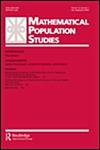Bridging data exploration and modeling in event-history analysis: the supervised-component Cox regression
IF 1.3
3区 社会学
Q3 DEMOGRAPHY
引用次数: 1
Abstract
ABSTRACT In event-history analysis with many possibly collinear regressors, Cox’s proportional hazard model, like all generalized linear models, can fail to be identified. Dimension-reduction and regularization are therefore needed. Penalty-based methods such as the ridge and the least absolute shrinkage and selection operator (LASSO) provide a regularized linear predictor, but fail to highlight the predictive structures. This is the gap filled by the supervised-component Cox regression (SCCoxR). Its principle is to compute a sequence of orthogonal explanatory components, which both rely on the strong correlation structures of regressors and optimize the goodness-of-fit of the model. One of its parameters tunes the balance between component strength and goodness of fit, thus bridging the gap between classical Cox regression with Cox regression on principal components. A second parameter allows the focus on subsets of highly correlated explanatory variables. A third parameter tunes the regularization of the model coefficients, leading to more robust estimates. Simulations show how to tune the parameters. The method is applied to the case study of polygamy in Dakar, Senegal.事件历史分析中的桥接数据探索和建模:监督成分Cox回归
在具有许多可能共线性回归量的事件历史分析中,Cox比例风险模型与所有广义线性模型一样,可能无法识别。因此需要降维和正则化。基于惩罚的方法,如脊和最小绝对收缩和选择算子(LASSO)提供了一个正则化的线性预测器,但不能突出预测结构。这是由监督成分Cox回归(SCCoxR)填补的空白。其原理是计算一系列正交解释成分,这些解释成分既依赖于回归量的强相关结构,又能优化模型的拟合优度。其中一个参数调节了成分强度和拟合优度之间的平衡,从而弥合了经典Cox回归与主成分Cox回归之间的差距。第二个参数允许关注高度相关的解释变量的子集。第三个参数调整模型系数的正则化,导致更稳健的估计。仿真显示了如何调整参数。该方法应用于塞内加尔达喀尔一夫多妻制的个案研究。
本文章由计算机程序翻译,如有差异,请以英文原文为准。
求助全文
约1分钟内获得全文
求助全文
来源期刊

Mathematical Population Studies
数学-数学跨学科应用
CiteScore
3.20
自引率
11.10%
发文量
7
审稿时长
>12 weeks
期刊介绍:
Mathematical Population Studies publishes carefully selected research papers in the mathematical and statistical study of populations. The journal is strongly interdisciplinary and invites contributions by mathematicians, demographers, (bio)statisticians, sociologists, economists, biologists, epidemiologists, actuaries, geographers, and others who are interested in the mathematical formulation of population-related questions.
The scope covers both theoretical and empirical work. Manuscripts should be sent to Manuscript central for review. The editor-in-chief has final say on the suitability for publication.
 求助内容:
求助内容: 应助结果提醒方式:
应助结果提醒方式:


